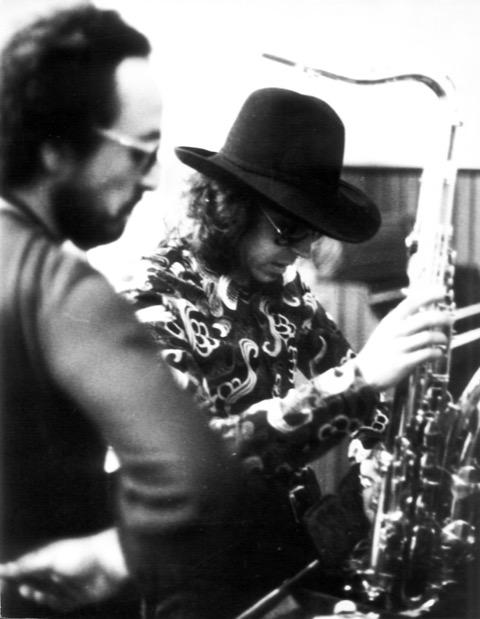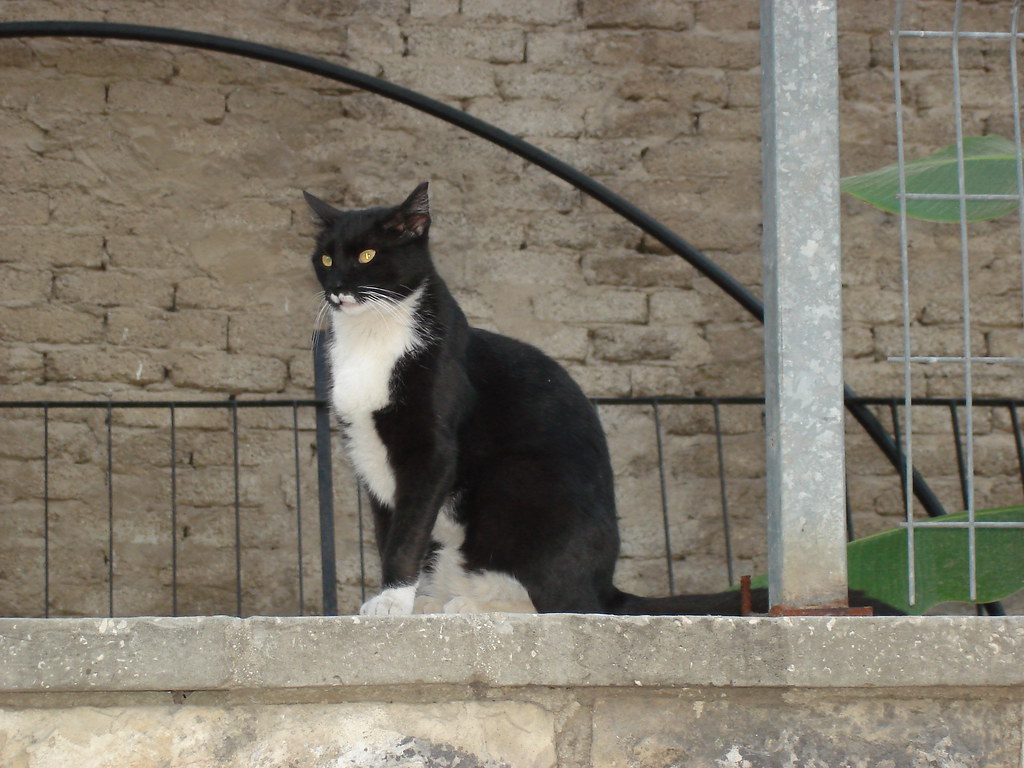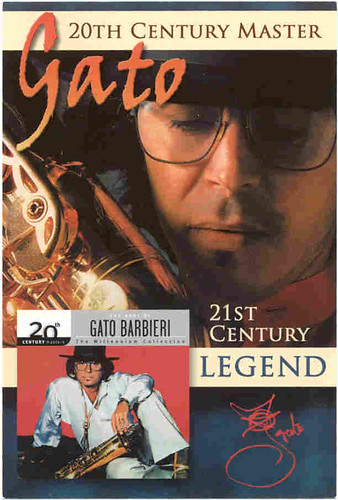
FEATURE image: “RICH FREE-6” by jeanmimi 2000 is licensed under CC BY-SA 2.0.
Shadow of the Cat was Grammy-nominated for Best Latin Jazz. Gato Barbieri looked to two major sources for the album’s inspiration. The first was the 30th anniversary of his Last Tango in Paris (1972) for which Barbieri won a Grammy Award for the film score. The second was his huge-toned, raucous yet smooth jazz-pop sound Barbieri created in five albums he made at A&M Records in the mid-to-late-1970’s.
Following a six decade career as a music original, Gato Barbieri died on April 2, 2016 at 83 years old.
Latin Grammy Lifetime Achievement in 2015. “What do you play?”
By 2006 Gato Barbieri was content that in a long musical career he had pursued playing different musical styles—jazz, Latin, film orchestration, etc.—and did not limit himself to a single genre.
In November 2015 Gato Barbieri received the Latin Grammy Lifetime Achievement Award for music that has been described as “mystical yet fiery, passionately romantic yet supremely cool.” Around the same time, Barbieri gave his final concert at the Blue Note club in Greenwich Village. That was the club where the “Cat” first performed in 1985 and—still sporting his trademark black fedora hat—started performing again there in 2013 on a monthly basis until his last concert on November 23, 2015.
“The jazz people they don’t consider me a jazz musician. If I am Latin, they don’t consider me Latin. So I am here in the middle,” Gato said. “It’s a good thing. You know why? Because they say, ‘What do you play?’ I say, ‘I play my music — Gato Barbieri.’”
Mid1960’s- Jammin’ fusion.
Gato Barbieri and Italian-born wife Michelle married in 1960 and moved to Rome in 1962, where Gato began collaborating with American jazz trumpeter Don Cherry (1936-1995). The year is 1966. Tenor saxophonist Gato Barbieri is joined by trumpeter Don Cherry, jazz vibraphonist Karl Berger (German, b. 1935) and bassist Bo Stief (Danish, b. 1946). In 1966 Barbieri and Cherry recorded two albums for Blue Note—Complete Communion and Symphony For Improvisors. Also in that early era Gato recorded with jazz saxophonist and composer Steve Lacy (1934-2004) and South African pianist Abdullah Ibrahim (b. 1934).
Recordings for Flying Dutchman and Impulse!.
In the early 1970’s Barbieri recorded a handful of albums on the Flying Dutchman label and later signed with Impulse! where he recorded his classic “Chapter Series” which included Latin America and Hasta Siempre (both 1973), Viva Emiliano Zapata (1974) and Alive in New York (1975).
Barbieri’s free jazz meant he was playing with American jazz double bass player Charlie Haden (1937-2014) and American jazz pianist Carla Bley (b. 1936), among many others. The Cat could also be found jamming with jazz bassist Stanley Clarke (b. 1951), Brazilian jazz drummer and percussionist Airto Moreira (b. 1941), Cuban composer Chico O’Farrill (1921-2001) and American jazz musician Lonnie Liston Smith (b.1940).
Gato Barbieri’s free-jazz playing and improvised style that mined Latin jazz in multi-artist projects in the late 1960s and early 1970s attracted Italian film director Bernardo Bertolucci (1941-2018) for his next film project. In 1972 Bertolucci recruited Gato Barbieri to compose the score for Bertolucci’s brutal sex-fantasy film Last Tango in Paris (1973) starring Marlon Brando and Maria Schneider.
Bertolucci hired Barbieri to incorporate the Italian director’s ideas for an original blend of jazz, strings, and tangos to embody his highly controversial X-rated film’s chaos of spirit and ferocious sexuality that gave nod to American and European avant-gardists with a splash of Hollywood popularity. The musical score for Last Tango in Paris was a professional triumph for the 41-year-old Gato Barbieri.

The film, censored and disliked across a range of groups as well as whole nations, received two Academy Award nominations – for Best Actor for Marlon Brando’s performance and Best Director for Bertolucci. At the April 1974 ceremony, Oscar in both categories, went to others – respectively, Jack Lemmon for Save the Tiger and George Roy Hill for The Sting. The film was neither nominated for Best Foreign Language Film, nor was its musical score recognized in any way.
After Last Tango in Paris opened in New York City on February 1, 1973, Gato Barbieri’s musical score was an instant international sensation. In March 1974, at the 16th Annual Grammy Awards in Los Angeles, Gato Barbieri won the Grammy Award for Best Instrumental Composition (“Album of Best Original Score Written For A Motion Picture Or A Television Special”) for his work on Last Tango in Paris.

Gato Barbieri performed benefit concerts, one for the Friends of Chile benefit concert in Madison Square Garden on May 6, 1974. Gato Barbieri’s five albums on A&M Records in the mid-to-late 1970s featured a more soothing jazz-pop sound.
Caliente! (1976) on A&M Records was released at the beginning of the peak of the jazz-fusion and disco eras. Produced by Herb Alpert, Gato Barbieri plays with sizzling heat relying on tango-infused Argentine fluency as well as the influence of Sonny Rollins (b.1930), John Coltrane (1926-1967) and Pharoah Sanders (b. 1940).
Caliente! is beautifully arranged and executed which makes for enjoyable listening. The concept of strings combined with rhythmic danceable funk anted up Barbieri’s raucous sound and made Caliente! a successful primogeniture to Herb Alpert’s instrumental Rise in 1979 which became a huge international hit.
“Tango is tragedy.”
“Always in the tango is tragedy,” said Barbieri in 1997. “She leaves him, she kills him. It’s like an opera—but it’s called tango.”
In the 1980s the “Cat” kicked it up a notch for Para Los Amigos (1984), an album which spotlighted the rock-influenced South American sound.

By the early 1990’s Gato had taken time off from creating in order to evaluate his musical style and identity going forward. Suddenly, in 1995, Michelle Barbieri, his wife of 36 years, as well as manager and confidant, died. In deep bereavment, Gato took up his saxophone and began to record again. This effort soon produced the 1997 album, Qué Pasa, Gato Barbieri’s first album of the decade.
In 1996 Gato Barbieri married his wife Laura and they soon had Christian, their son. After Gato’s death on April 2, 2016 at 83 years old, Laura Barbieri told The Associated Press: “Music was a mystery to Gato, and each time he played was a new experience for him, and he wanted it to be that way for his audience.”
SOURCES:
Barbieri’s 50th album, “Shadow of the Cat” released in September 2002 on Peak Records – http://www.allmusic.com/album/the-shadow-of-the-cat-mw0000225929
two sources for its inspiration… – http://www.allmusic.com/album/the-shadow-of-the-cat-mw0000225929
won a Grammy Award for his film score – http://www.billboard.com/articles/columns/latin/7318824/gato-barbieri-dead
five albums at A&M Records in mid-to-late-1970’s. – http://www.concordmusicgroup.com/artists/gato-barbieri/
in 2015 Latin Grammy Lifetime Achievement Award – http://www.billboard.com/articles/columns/latin/7318824/gato-barbieri-dead
“Mystical yet fiery…” quotation – http://www.concordmusicgroup.com/artists/gato-barbieri/
First performed at Blue Note – http://www.nytimes.com/2016/04/03/arts/music/gato-barbieri-latin-jazz-trailblazer-dies-at-83.html
Perform monthly since 2013 – http://highlighthollywood.com/2016/04/latin-jazz-saxophonist-gato-barbieri-dies-at-age-83-highlight-hollywood-news/
gives his final concert – http://www.tff.gr/nea/arthro/to_teleutaio_tangko_tou_leantro_gkato_mparmpieri_vds-130329325/
“‘I play my music — Gato Barbieri’” quotation – http://www.nytimes.com/2016/04/03/arts/music/gato-barbieri-latin-jazz-trailblazer-dies-at-83.html
Evaluate his musical style and identity-https://www.encyclopedia.com/education/news-wires-white-papers-and-books/barbieri-gato





